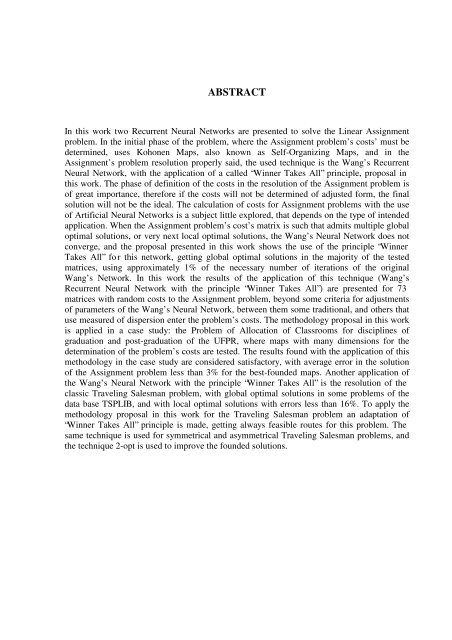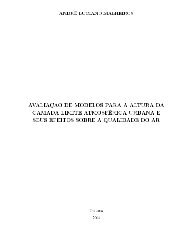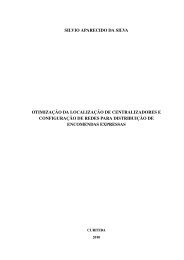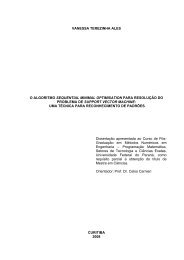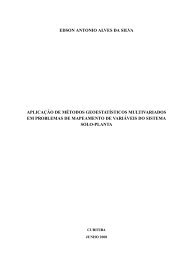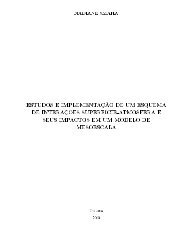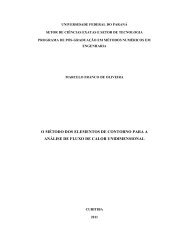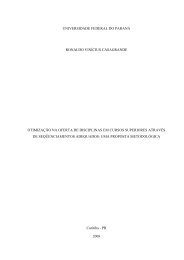uma nova abordagem na resolução do problema do caixeiro viajante
uma nova abordagem na resolução do problema do caixeiro viajante
uma nova abordagem na resolução do problema do caixeiro viajante
You also want an ePaper? Increase the reach of your titles
YUMPU automatically turns print PDFs into web optimized ePapers that Google loves.
ABSTRACT<br />
In this work two Recurrent Neural Networks are presented to solve the Linear Assignment<br />
problem. In the initial phase of the problem, where the Assignment problem’s costs’ must be<br />
determined, uses Kohonen Maps, also known as Self-Organizing Maps, and in the<br />
Assignment’s problem resolution properly said, the used technique is the Wang’s Recurrent<br />
Neural Network, with the application of a called “Winner Takes All” principle, proposal in<br />
this work. The phase of definition of the costs in the resolution of the Assignment problem is<br />
of great importance, therefore if the costs will not be determined of adjusted form, the fi<strong>na</strong>l<br />
solution will not be the ideal. The calculation of costs for Assignment problems with the use<br />
of Artificial Neural Networks is a subject little explored, that depends on the type of intended<br />
application. When the Assignment problem’s cost’s matrix is such that admits multiple global<br />
optimal solutions, or very next local optimal solutions, the Wang’s Neural Network <strong>do</strong>es not<br />
converge, and the proposal presented in this work shows the use of the principle “Winner<br />
Takes All” fo r this network, getting global optimal solutions in the majority of the tested<br />
matrices, using approximately 1% of the necessary number of iterations of the origi<strong>na</strong>l<br />
Wang’s Network. In this work the results of the application of this technique (Wang’s<br />
Recurrent Neural Network with the principle “Winner Takes All”) are presented for 73<br />
matrices with ran<strong>do</strong>m costs to the Assignment problem, beyond some criteria for adjustments<br />
of parameters of the Wang’s Neural Network, between them some traditio<strong>na</strong>l, and others that<br />
use measured of dispersion enter the problem’s costs. The metho<strong>do</strong>logy proposal in this work<br />
is applied in a case study: the Problem of Allocation of Classrooms for disciplines of<br />
graduation and post-graduation of the UFPR, where maps with many dimensions for the<br />
determi<strong>na</strong>tion of the problem’s costs are tested. The results found with the application of this<br />
metho<strong>do</strong>logy in the case study are considered satisfactory, with average error in the solution<br />
of the Assignment problem less than 3% for the best-founded maps. Another application of<br />
the Wang’s Neural Network with the principle “Winner Takes All” is the resolution of the<br />
classic Traveling Salesman problem, with global optimal solutions in some problems of the<br />
data base TSPLIB, and with local optimal solutions with errors less than 16%. To apply the<br />
metho<strong>do</strong>logy proposal in this work for the Traveling Salesman problem an adaptation of<br />
“Winner Takes All” principle is made, getting always feasible routes for this problem. The<br />
same technique is used for symmetrical and asymmetrical Traveling Salesman problems, and<br />
the technique 2-opt is used to improve the founded solutions.


